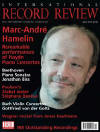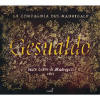Texte paru dans: / Appeared in:
*

International Record Review - (04/2013)
Pour
s'abonner / Subscription information
Glossa
GCD922801

Code-barres / Barcode : 8424562228016
(ID275)
Appréciation d'ensemble/ Evaluation : "Strongly recommended for bracing, not easy listening."
It is understandably hard to resist linking the dramatic, not to say lurid, biography of Carlo Gesualdo a depressive, a masochistic homosexual, a religious obsessive and to top it ail a double murderer with his wildly unsettling and highly chromatic music. He was the Prince of Venosa who openly murdered his wife and her lover. Interestingly, the family of his second wife, the Estes, had many decades before patronized and protected another composer who had murdered his unfaithful wife: Bartolomeo Tromboncino. The earlier composer’s breezy and tuneful frottole betray none of the anguish bordering on madness that many hear in Gesualdo’s music. These include the film director Werner Herzog, whose 1995 film (which I have not seen) was entitled Gesualdo - Death in Five Voices and apparently presents the composer as little short of a madman. But is the music really as directly influenced by the biography as is often supposed? There is no doubt that Gesualdo was an extreme character in many ways, so it is unsurprising that his music is all very avant-garde. What Marco Bizzarini attempts to do in his fascinating booklet essay is to remind us that Gesualdo was part of an experimental intellectual and artistic movement, not a solitary lunatic. He had numerous musical disciples such as de Macque, d’India, Michelangelo Rossi and even Frescobaldi, to some extent. As Bizzarini also points out, some of his contemporaries found his music greatly refined and with exquisite counterpoint not the utterances of a madman. Ultimately, Gesualdo’s ultra-experimental style did not long survive the Monteverdian revolution, which showed that pleasing melody could be consistent with high technical sophistication.
If you want to hear what all the fuss is about, the Sixth Book of Madrigals is the place to go, with its sometimes word-by-word pictorialism, shocking chromaticism and eschewal of any easy melodies (or practically any at all, really). Gesualdo rather sneered at the tuneful and agreeable madrigalian style of contemporaries such as Marenzio and Books V and VI are his studied rebuke. The most famous work in the set is probably ‘Moro, lasso, al mio duolo’, which is knife-twisting in its anguished intensity. But there is more to Gesualdo than this, for the very next works, ‘Volan quasi farfalle’ and ‘Al mio gioir it ciel si fa serno’, are by his standards positively light-hearted.
Such madrigals obviously demand singers of the highest skill and understanding. No vocal group, I venture, is better equipped to tackle music that is so fearsomely complex and often florid than La Compagnia del Madrigale. Although this is only the recently formed group’s second disc, its members have many years of experience in the late-Renaissance and early-Baroque vocal repertory with such prominent ensembles as Concerto Italiano and La Venexiana. Unlike some performers of Gesualdo, they sing with no instrumental accompaniment, rightly confident that their laser-sharp tuning, strong individual voices and impeccable technique will suffice to deal with his manifold challenges. Whilst each singer occasionally allows a slight expressive tremble to colour a particular word or note, there is no constant vibrato, which would obviously be quite inimical to music with such quicksilver lability as this. Following Renaissance practice, they have transposed the music down from its written pitch to one more suitable (not to say attainable) for the higher voices. This is singing of immense confidence, polish and maturity. As performed by La Compagnia del Madrigale, each madrigal is an extraordinary mini-drama that repays repeated hearing.
The recording was made in a Renaissance church in Roletto, Italy. In contrast to some church recordings, there is no swamping by a reverberant acoustic every voice can be heard with startling clarity. Strongly recommended for bracing, not easy listening.
Cliquez l'un ou l'autre
bouton pour découvrir bien d'autres critiques de CD
Click either button for many other reviews


